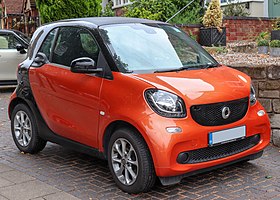| Smart Fortwo | |
|---|---|
 | |
| Overview | |
| Manufacturer | Daimler-Benz (1998) DaimlerChrysler (1998–2007) Daimler AG (2007–2022) Mercedes-Benz Group (2022–2024) |
| Also called | Smart City-Coupé (1998–2002) Smart car (colloquially) |
| Production | 1998–2007 (MkI) 2006–2014 (MkII) 2014–2024 (MkIII) |
| Assembly | France: Hambach (Smartville) |
| Body and chassis | |
| Class | City car Microcar[1] |
| Body style | 3-door hatchback 2-door convertible |
| Layout | Rear-engine, rear-wheel-drive Rear-motor, rear-wheel drive (Electric Version) |
| Related | Smart Roadster Smart Forfour |
The Smart Fortwo (stylized as "smart fortwo") is a two-seater city car manufactured and marketed by the Smart division of the Mercedes-Benz Group for model years 1998-2024, across three generations — each using a rear-engine, rear-wheel-drive layout and a one-box design.
The first generation was internally designated as the W450, launched at the 1998 Paris Motor Show. The second generation W451-build series was launched at the 2006 Bologna Motor Show.[2] The third generation Fortwo (2014–2024) was internally designated as the C453 build series,[3][4] and debuted globally on July 16, 2014,[5] at the Tempodrom in Berlin[6] along with a closely related four-door version, the Smart Forfour, co-developed and sharing the same platform and engines with the third-generation Renault Twingo.
Marketed in 46[7] countries worldwide, Fortwo production had surpassed 1.7 million units by early 2015.[8][9][3] The brand name Smart supposedly derives from its early history as a cooperative venture between Swatch and Mercedes: Swatch Mercedes ART.[10] The Fortwo nameplate derives from its two-person seating capacity.[1] Until 2002, the Fortwo had been marketed as the smart City-Coupé.
- ^ a b Farenc, Jacques (1998), Norris, Ian (ed.), "European Industry: Mergers and Acquisitions", Automobile Year, 46 (1998–99), Lausanne, Switzerland: Editions JR, J.-R. Piccard: 44–45, ISBN 978-2-88324-054-4
- ^ "Geneva Motor Show 2007 – Highlights". Car Design News, March 7, 2007. Archived from the original on March 6, 2014.
- ^ a b Lowney, Damon (2013-07-18). "Smart celebrates 1.5 million Fortwo models built, prepares to upgrade factory". Autoblog.
- ^ "The Smart rehearsing the Snow Waltz (in German)". Autobild. March 17, 2014.
- ^ Cite error: The named reference
geheimniswas invoked but never defined (see the help page). - ^ "World premiere of the new smart fortwo and forfour on 16 July in Berlin". Daimler AG. Archived from the original on 2014-07-20. Retrieved 2014-07-15.
- ^ "Celebrating 20 Years of History: smart Hambach Plant Writes Next Chapter of its Success Story". Daimler Press, via AutoChannel.com.
- ^ "New Vehicle Generation Provides Foundation for Growth 2015". Daimler.com, January 5, 2015. Archived from the original on July 3, 2015. Retrieved January 6, 2015.
- ^ Horrell, Paul (August 28, 2014). "Smart CEO Annette Winkler: The World Needs This Car". Motor Trend.
- ^ "SMART". Acronyms.thefreedictionary.com. Retrieved 2009-03-12.